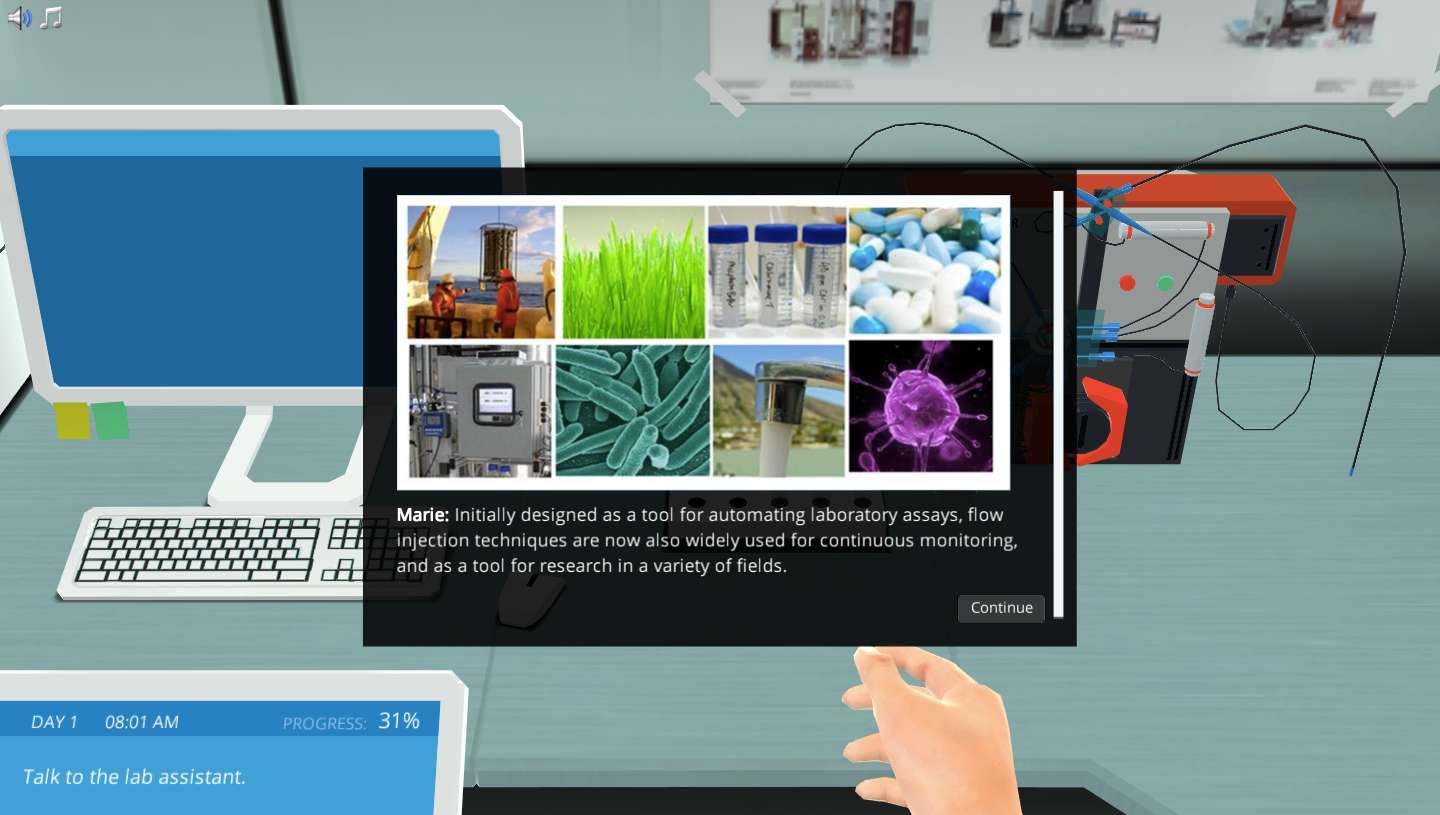Heading 1
Heading 2
Heading 3
Heading 4
Heading 5
Heading 6
Lorem ipsum dolor sit amet, consectetur adipiscing elit, sed do eiusmod tempor incididunt ut labore et dolore magna aliqua. Ut enim ad minim veniam, quis nostrud exercitation ullamco laboris nisi ut aliquip ex ea commodo consequat. Duis aute irure dolor in reprehenderit in voluptate velit esse cillum dolore eu fugiat nulla pariatur.
Block quote
Ordered list
- Item 1
- Item 2
- Item 3
Unordered list
- Item A
- Item B
- Item C
Bold text
Emphasis
Superscript
Subscript
About This Simulation
Let’s awaken your curiosity for the chemistry of caffeine. Learn how Flow Injection Analysis (FIA) helps scientists measure the concentration of caffeine in your drinks.
Learning Objectives
- Measure caffeine concentration in different samples using the Flow Injection Analysis (FIA) technique
- Describe the importance of the different parts of the FIA machine (e.g. the spectrophotometer, the pump, or the mixing coil)
- Describe the advantages of the FIA method
- Calculate the velocity at which a sample will be eluted
- Prepare sample dilutions and standard curves
- Interpret the results from a FIA experiment
- Determine the concentration of an unknown caffein sample by using the standard curve
About This Simulation
Lab Techniques
- Flow Injection Analysis
Related Standards
- HS-PS1-3, HS-PS2-6
- 3.9 Separation of Solutions and Mixtures Chromatography
- B.9 Biological Pigments
Learn More About This Simulation
Lego blocks and caffeine make an interesting combo. In this simulation, you will learn that a couple of scientists actually used lego blocks to build the first version of the Flow Injection Analysis (FIA) machine. You’ll use the technique to measure caffeine levels in various beverages.
Explore the parts of the flow injection machine
Not every real-life lab has a FIA machine, and it’s definitely not everyday that you get to look inside one. So in this simulation, you’ll get to explore the different parts of the FIA machine in detail through a 3D animation that illustrates the main mechanisms of the machine. You’ll soon understand how the machine detects caffeine, and apply this knowledge to your experiments.
Optimize and perform the experiment
Before you carry out an experiment, you will have to optimize the FIA machine for use. You can alter different machine parameters, to help generate the most accurate results. Once you have optimized the machine and prepared samples, you are ready to perform your experiment! Lots of beverages are waiting to be tested.
Compute the caffeine concentration
When you have finished your experiment, you’ll want to present your results in the best way possible. After creating an absorbance graph, you’ll employ your stoichiometry knowledge to determine the caffeine concentration of each beverage.
Maybe coffee is not the best drink for getting up or staying awake after all… maybe it’s hot chocolate! Will you be able to find out which beverages will cure you from sleepiness?
For Science Programs Providing a Learning Advantage
Boost STEM Pass Rates
Boost Learning with Fun
75% of students show high engagement and improved grades with Labster
Discover Simulations That Match Your Syllabus
Easily bolster your learning objectives with relevant, interactive content
Place Students in the Shoes of Real Scientists
Practice a lab procedure or visualize theory through narrative-driven scenarios


FAQs
Find answers to frequently asked questions.
Heading 1
Heading 2
Heading 3
Heading 4
Heading 5
Heading 6
Lorem ipsum dolor sit amet, consectetur adipiscing elit, sed do eiusmod tempor incididunt ut labore et dolore magna aliqua. Ut enim ad minim veniam, quis nostrud exercitation ullamco laboris nisi ut aliquip ex ea commodo consequat. Duis aute irure dolor in reprehenderit in voluptate velit esse cillum dolore eu fugiat nulla pariatur.
Block quote
Ordered list
- Item 1
- Item 2
- Item 3
Unordered list
- Item A
- Item B
- Item C
Bold text
Emphasis
Superscript
Subscript
A Labster virtual lab is an interactive, multimedia assignment that students access right from their computers. Many Labster virtual labs prepare students for success in college by introducing foundational knowledge using multimedia visualizations that make it easier to understand complex concepts. Other Labster virtual labs prepare learners for careers in STEM labs by giving them realistic practice on lab techniques and procedures.
Labster’s virtual lab simulations are created by scientists and designed to maximize engagement and interactivity. Unlike watching a video or reading a textbook, Labster virtual labs are interactive. To make progress, students must think critically and solve a real-world problem. We believe that learning by doing makes STEM stick.
Yes, Labster is compatible with all major LMS (Learning Management Systems) including Blackboard, Canvas, D2L, Moodle, and many others. Students can access Labster like any other assignment. If your institution does not choose an LMS integration, students will log into Labster’s Course Manager once they have an account created. Your institution will decide which is the best access method.
Labster is available for purchase by instructors, faculty, and administrators at education institutions. Purchasing our starter package, Labster Explorer, can be done using a credit card if you are located in the USA, Canada, or Mexico. If you are outside of North America or are choosing a higher plan, please speak with a Labster sales representative. Compare plans.
Labster supports a wide range of STEM courses at the high school, college, and university level across fields in biology, chemistry, physics, and health sciences. You can identify topics for your courses by searching our Content Catalog.















